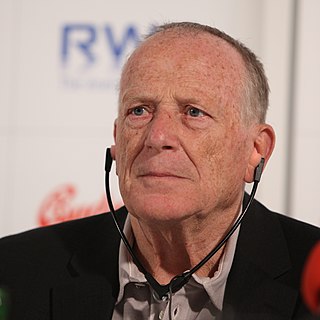![<i>Ernst Thälmann</i> (film) 1954 [[East Germany]] film](https://upload.wikimedia.org/wikipedia/commons/thumb/e/eb/Fotothek_df_roe-neg_0006580_014_Bild_Litfa%C3%9Fs%C3%A4ule_mit_Filmplakaten_f%C3%BCr_%22Ernst_Th%C3%A4.jpg/320px-Fotothek_df_roe-neg_0006580_014_Bild_Litfa%C3%9Fs%C3%A4ule_mit_Filmplakaten_f%C3%BCr_%22Ernst_Th%C3%A4.jpg)
Ernst Thälmann is an East German propaganda film in two parts about the life of Ernst Thälmann, leader of the Communist Party of Germany during much of the Weimar Republic, directed by Kurt Maetzig and starring Günther Simon in the title role. The first part, Ernst Thälmann - Sohn seiner Klasse, was released in 1954. It was followed by the 1955 sequel. Ernst Thälmann - Führer seiner Klasse.
Girls in Gingham —sometimes called Beaverskin—is a 1949 German drama film directed by Kurt Maetzig.

Wolfgang Kohlhaase was a German screenwriter, film director, and writer. He was considered "one of the most important screenwriters in German film history", and was one of the GDR's most well-known and prolific film screenwriters. Kohlhaase was awarded the Honorary Golden Bear at the 2010 Berlin International Film Festival.

Familie Benthin is an East German film. It was released in 1950.
Der Rat der Götter is an East German black-and-white film, directed by Kurt Maetzig. It was released in 1950.

The Call of the Sea or The Oceans Are Calling is a 1951 East German drama film directed by Eduard Kubat and starring Hans Klering, Käte Alving and Evamaria Bath. A defector to West Germany returns to the East, having become disillusioned by capitalist society.

The Condemned Village is a 1952 East German propaganda film directed by Martin Hellberg.The film is about a man who returns from a Soviet prisoner-of-war camp to his home village in occupied West Germany and leads a resistance to the American military's plans to demolish the village to build an airfield. The film was commissioned to build East German opposition to the United States and support for the Soviet Union during the early Cold War.
Alarm in the Circus is an East German crime film directed by Gerhard Klein. It was released in 1954.
![<i>A Berlin Romance</i> 1956 [[East Germany]] film](https://upload.wikimedia.org/wikipedia/en/3/35/Eine_Berliner_Romanze_1956.jpg)
A Berlin Romance is a 1956 East German neo-realist romantic drama film about youth urban life in the divided city of Berlin, directed by Gerhard Klein. It was produced by the DEFA film company. It stars Annekathrin Bürger, Ulrich Thein and Uwe-Jens Pape. The script was written by Wolfgang Kohlhaase with a score composed by Günter Klück. The film was the second collaboration between Klein and Kohlhaase; the first was Alarm in the Circus, released in 1954 and third came in 1957 with Berlin - Ecke Schönhauser. These films were noted for their strong criticism of consumer culture in Berlin after World War II and the Americanization of the capital and are amongst DEFA's best known films.
Schlösser und Katen is an East German black-and-white film, directed by Kurt Maetzig. It was released in 1957.
Don't Forget My Little Traudel is an East German comedy film, directed by Kurt Maetzig. It was released in 1957.

The Sailor's Song is an East German black-and-white film directed by Kurt Maetzig and Günter Reisch. It was released in 1958.
Before the Lightning Strikes is an East German comedy film directed by Richard Groschopp. It was released in 1959.
Maibowle is an East German musical comedy film, released in 1959. It was directed by Günter Reisch.
Love's Confusion is an East German romantic comedy film directed by Slátan Dudow. It was released in 1959.
Zu jeder Stunde is an East German black-and-white film, directed by Heinz Thiel. It was released in 1960.
September Love is an East German film directed by Kurt Maetzig. It was released in 1961.
At A French Fireside is an East German film directed by Kurt Maetzig. It was released in 1963.
Sun Seekers is an East German film, directed by Konrad Wolf during 1958. It was banned and subsequently released only in 1972.
![<i>The Axe of Wandsbek</i> (1951 film) 1951 [[East Germany]] film](https://upload.wikimedia.org/wikipedia/en/6/66/Beil_von_Wandsbek%2C_Das.jpg)
The Axe of Wandsbek is a 1951 East German film, directed by Falk Harnack.

![<i>Ernst Thälmann</i> (film) 1954 [[East Germany]] film](https://upload.wikimedia.org/wikipedia/commons/thumb/e/eb/Fotothek_df_roe-neg_0006580_014_Bild_Litfa%C3%9Fs%C3%A4ule_mit_Filmplakaten_f%C3%BCr_%22Ernst_Th%C3%A4.jpg/320px-Fotothek_df_roe-neg_0006580_014_Bild_Litfa%C3%9Fs%C3%A4ule_mit_Filmplakaten_f%C3%BCr_%22Ernst_Th%C3%A4.jpg)




![<i>A Berlin Romance</i> 1956 [[East Germany]] film](https://upload.wikimedia.org/wikipedia/en/3/35/Eine_Berliner_Romanze_1956.jpg)

![<i>The Axe of Wandsbek</i> (1951 film) 1951 [[East Germany]] film](https://upload.wikimedia.org/wikipedia/en/6/66/Beil_von_Wandsbek%2C_Das.jpg)